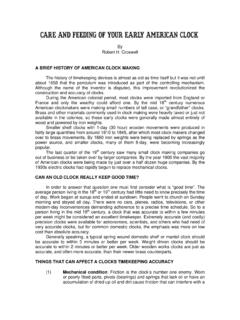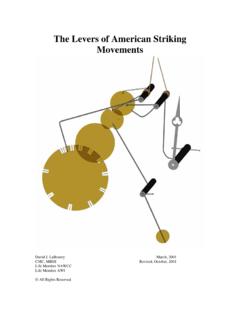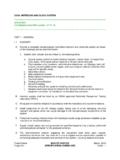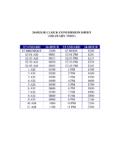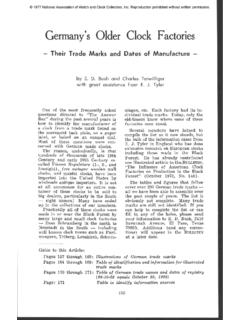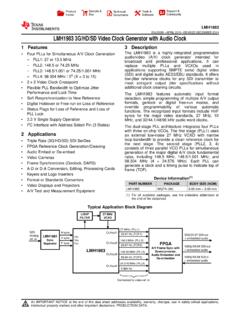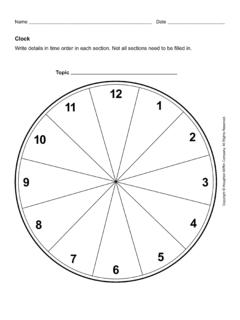Transcription of This is part 1 of 2 on servicing the 400-day …
1 1. This is part 1 of 2 on servicing the 400-day ( anniversary ) clock . This article will be a 2-part series devoted to the servicing of the 400-day or anniversary clock by Michael P. Murray. Mike was AWI's 400-day clock repair bench course Instructor. The 400-day course is a 2-day hands on affair with the students working on the clock that they bring and Mike can accommodate anywhere from 8 to 16 students. For more information about Mike please see his Website at: This article is copyrighted to the author and references. Members, In my initial series on the 400-day clock , we will cover final assembly right through final timing. My assumption is that we all know the basics but it's the last seemingly basis steps where most of the troubles occur when servicing this slightly temperamental timepiece. My goal in writing these articles is to get you past many of the pitfalls and erroneous assumptions. There are no real secrets and I hope to enable anyone who reads this by dispelling any fears or myths.
2 So if you're not currently servicing the 400-day , I urge you to give them another try. Series Assumptions A quick mention of what I expect as the basis . You're checked for and corrected any pivot, tooth, or gear depthing problems (depthing problems are extremely rare), used a mainspring winder to remove and install the mainspring, cleaned and lubricated same, pegged all pivot holes, polished all pivots and pivot shoulders, polished the anchor pin and the inside of the fork tines, and cleaned all parts. My last assumption is that you have one of the editions of Horolovar's the 400-day clock Repair Guide . My personal preference is the latest edition, the 10th, and I'll be using that as my reference and for examples. Test of Train Operation First assemble the movement up to but NOT including the anchor or verge , if you prefer. Leave off the motions works, suspension spring and don't mount it to its base. With the movement assembled, place a tiny drop of your favorite oil on all pivot holes.
3 Wind the mainspring a turn and the train should run freely. If not then please determine why and remedy the situation. Look for anything you'd look for in any other clock movement, broken, tapered, or bent pivots, broken, bent or cracked teeth, broken, bent or cracked pinions and arbors, pivot shoulders must be at a right angle to the pivots, lack of or too much end shake in all arbors, pivot freedom or lack of it in their holes and so forth. Okay, the movement is moving smoothly. Before you take off the remaining power and install the anchor, check that the anchor pin is vertical to the pallets. A quick check is to lay it on a flat surface with the pallets down. The anchor pin must be perpendicular to the flat surface. If not then you can slightly bent the anchor pin or its' bushing , if it's so equipped. (Notes: The original anchor pins for Gustav Becker clocks are hardened and should not be bent until they have been annealed. Some of the Kundo miniatures were equipped with an anchor pin bent backwards.)
4 This caused poor pendulum rotation. The solution (B below) is too replace the anchor pin with one that has been bent at a slightly smaller than right angle (backwards), then straight toward the plate and finally bent a slightly less than a right angle to come in contact with the fork. 1. 2. Most anchor pins are threaded and screwed into the pallet base but I have seen these pins soldered. Just be sure how the anchor pin is secured and if it's hardened, BEFORE you make any adjustments and have a look on pages 42 & 43 in the 10th edition, for most of the variations on anchors and escape wheels. If you do bent the anchor pin then repolish it and I use 4/0 steel wool followed by 4/0 emery paper. Remove the remaining power, install the anchor and wind the mainspring one turn. Use your finger as the fork and slowly rock the anchor pin back and forth and check each escape tooth for lock and drop. This Graham deadbeat escapement must have equal and tight drops and the locks must occur above the pallet faces.
5 The pallets should have an initial lock of only about 1/32 inch ( mm) above the pallet face, too deep a lock will cause the clock to stop (the suspension fork can't turn far enough each way to unlock the pallets) and if it is too shallow the escapement will "flutter", causing the clock to gain a large amount of time. Ideally, lock and drop will be equal for all entry and exit pallets. Please DON'T adjust the pallets unless you are absolutely sure they need adjusting. I have never come across a factory set escapement that was incorrect. Past repair intervention is almost always the case for poor escapement action. There is not much angular motion of the pallets and this makes the relative position of the escape teeth and pallet length essential. The pallets should be of equal length and you'll have to measure this if the escapement presents a problem. The best explanation and adjustments of the Graham deadbeat escapement is covered on pages 42 to 52 in the10th edition.
6 Suspension Unit Manufacture . So far we have good transfer of power and good escapement action. Now we head for the suspension unit. Here's where the problems usually occur for the repair person. I ALWAYS purchase genuine Horolovar suspension springs. I state this simply because all the material in the 10th edition is predicated on using that spring. I always make it myself but you can purchase units already made, if they are Horolovar. When making the suspension unit, you must use Sections 9 and 10 of the Repair Guide. In using these sections, we should understand all the information that is given to us. I'm going to use plate # 1520AA, which is found on page 152. Section 9 is laid out in alphabetical order using the first letter in the first word on the back plate. As an example, S. Haller would be found under the letter S . 2. 3. One of the most important things to remember when using Section 9 is that Horolovar tries to illustrate as many back plates as possible but many times the information about a particular set of back plates is exactly the same.
7 As in the group of 4 back plate illustrations associated with plate #. 1520, which can be found on pages 151 and 152. You should see four back plates in this series from plate # 1520 to plate # 1520 AAA. If you look at the information given it is exactly the same for each plate. Some groups of plates will have the same information with some slight variations. I point this out because I don't want you to become obsessed with finding the exact back plate configuration. A little common sense will help a great deal when using Section 9. I'll explain each bit of information, which is found on each back plate in Section 9 and each suspension unit in Section 10 of the Repair Guide. The following illustrations are very close to scale but not an exact duplicate of what you will find in the Horolovar 400-day clock Repair Guide 10th edition. I'll work from top to bottom and left to right concerning the back plate information in Section 9 of the Repair Guide. Explanations Sigfried Haller made this movement around 1960.
8 The upper left corner indicates who the manufacturer is and the upper right corner indicates the approximate date the movement was made. Below the back plate illustration we find the following: The plate # (Plate 1520AA) is just used for identification purposes by Horolovar. 4-ball Pendulum indicates the style of pendulum. USE .003 means the thickness of the Horolovar suspension spring to be used. Units 42, 42A (See below) indicates what suspension unit to make based on the illustrations in Section 10. (18 x 38) indicates the size of the mainspring required in this movement. Horolovar, in Section 17, list most of the sizes of mainsprings used in 400-day clocks. The 18 indicates the width of the mainspring and the 38 indicates the inside diameter of the mainspring barrel. The Appendix 63, 64, 108 refers to Section 18 of the Repair Guide and these notes or illustrations contain miscellaneous information such as schematics, special manufacturing information, various improvements, and other interesting information that you and your customer may like to know.
9 3. 4. In general, the Repair Guide is the bible for all 400-day work but it is not without errors and all know errors are covered in AWI's Bench Course on the 400-day clock . I have the privilege of being AWI's Instructor for these clocks and all incorrect information in the 10th edition of the Repair Guide, and all special circumstances are covered in detail during the 2-day bench course on the 400-day clock . The information below is found in Section 10 of the Repair Guide. 42- S. HALLER STANDARD 70 USE .003 (.076mm) HOROLOVAR. 8 beats per minute 42a - S. HALLER STANDARD 73 USE .003 (.076mm) HOROLOVAR. 8 beats per minute This Unit is functionally the same as Unit 42, but is equipped with a better-designed fork. Explanations The 42 and 42a are the Unit references from Section 9. The standard refers to the size of the movement. The 70 and 73 refer to the approximate date these suspension units went into service. Again the suspension spring thickness is mentioned.
10 8 beats per minute is the proper running speed and this will be used to time the clock . Most times there is a note about the particular suspension unit and these notes are extremely helpful and useful. The Repair Guide, Section 10, covers all manufacturers from 1949 to present but it does not cover many suspension units manufactured before that date. That's not to say Section 10 is useless for movements made before that date but what it does say is that exact duplicates of those earlier movements suspension units may not be in Section 10. This may mean that you may have to adjust the total length of the suspension spring slightly and/ or the position of the fork. If you do not find a particular back plate in Section 9 and need to make the suspension unit, then use Unit 6789 (Unit 9) from Section 10. An easy length check for clocks with pendulum cups on their bases is to observe the position of the center shaft of the pendulum as it relates to the cup.

